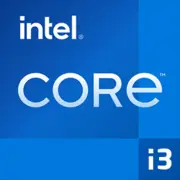Intel Core i3-6100H

Intel Core i3-6100H: Overview and Recommendations for Users in 2025
Processor for Basic Tasks or an Obsolete Chip?
In 2025, the laptop market is filled with processors based on a 5nm process technology, neural accelerators, and hybrid architectures. However, even now, some budget devices continue to use time-tested solutions like the Intel Core i3-6100H. Let’s explore who might find this processor relevant in 2025, what tasks it can handle, and what compromises must be made.
1. Architecture and Process Technology: Skylake in the Era of AI and 5G
The Intel Core i3-6100H is a representative of the Skylake generation (2015), manufactured using a 14nm process technology. It is a dual-core processor supporting Hyper-Threading (4 threads) with a base frequency of 2.7 GHz. There is no Turbo Boost mode, which limits its potential under short bursts of load.
Architecture Features:
- Skylake Cores: Improved IPC (instructions per cycle) by 10-15% compared to the previous Broadwell generation.
- Integrated Graphics Intel HD Graphics 530: 24 execution units, support for DirectX 12, 4K@60 Hz via HDMI 1.4/DisplayPort.
- Memory Support: DDR4-2133, LPDDR3-1866 (up to 64 GB).
How Does It Compare to Modern Chips?
- No support for PCIe 4.0/5.0 (only PCIe 3.0).
- Lack of hardware acceleration for AI tasks (e.g., background blurring in Zoom).
- Limited scalability: 2 cores create a bottleneck in multi-threaded scenarios (rendering, streaming).
2. TDP 35W: A Balance Between Performance and Heating
The 35W TDP positions the i3-6100H as a processor suited for thin laptops with passive or modest active cooling. However, in 2025 this figure seems excessive:
- Modern chips with similar performance (e.g., Intel Core i3-N305) have a TDP of 15W.
- In idle mode, the power consumption of Core i3-6100H is about 5-7W, which is higher than competitors at 7nm (2-3W).
Practical Consequences:
- Laptops with this CPU require large heatsinks, which increases weight (1.8-2.2 kg).
- Under load, fans can be noisy (up to 40 dB).
3. Performance: What to Expect in 2025?
Office Tasks:
- Document processing (Word, Excel), browser (10-15 tabs), Zoom — the processor can handle it, but running multiple applications simultaneously may cause slowdowns.
- Example: Running Excel + 15 Chrome tabs + Telegram consumes 80-90% of the CPU.
Multimedia:
- Watching 4K video: stable, thanks to decoding capabilities of the iGPU.
- Editing in DaVinci Resolve: only simple projects (1080p, 2-3 tracks). Rendering a 10-minute video will take 25-30 minutes (compared to 5-7 minutes on a Core i5-1240P).
Gaming:
- CS:GO — 720p, low settings, 40-50 FPS.
- Fortnite — 720p, 30 FPS with drops.
- Modern AAA titles (Cyberpunk 2077, Starfield) — unplayable even on minimum settings.
Turbo Mode: Absent, so brief loads (like opening a "heavy" website) do not receive acceleration.
4. Use Cases: Who Should Consider i3-6100H in 2025?
- Students: For lectures, writing reports, Zoom sessions.
- Office Workers: Working with 1C, Excel spreadsheets, corporate messengers.
- Users of "Digital Minimum": Surfing, YouTube, social media.
Not Recommended For:
- Gamers (except indie game enthusiasts).
- Freelancers working with graphics or video.
- Owners of 4K monitors (Windows interface may lag).
5. Battery Life: How Long Will the Laptop Last?
Average battery life for devices with i3-6100H is 4-6 hours (web surfing, 50% brightness). The reason is the high power consumption of the outdated 14nm architecture.
Power Saving Technologies:
- Intel SpeedStep: Dynamic frequency reduction at idle.
- C-States: Shutting down unused cores.
Tips to Increase Battery Life:
- Install an SSD (HDD increases power consumption).
- Disable background applications (e.g., OneDrive).
- Use "Battery Saver" mode in Windows.
6. Comparison with Competitors
AMD Ryzen 3 3200U (2019):
- 2 cores/4 threads, Vega 3 GPU.
- Pros: Better graphics (20-30% better), supports PCIe 3.0.
- Cons: Higher price for used devices ($250 vs. $200).
Apple M1 (2020):
- 4 cores/4 threads, 5nm process technology.
- Pros: 3-4 times higher performance, 18 hours of battery life.
- Cons: macOS only, new devices start at $800.
Intel Core i3-1115G4 (2020):
- 2 cores/4 threads, 10nm, Iris Xe Graphics.
- Pros: Supports Wi-Fi 6, Thunderbolt 4.
- Cons: On the secondary market, priced at $300-400.
7. Pros and Cons of Core i3-6100H
Strengths:
- Low cost of laptops (new models from $400).
- Adequate performance for basic tasks.
- 4K video support.
Weaknesses:
- Obsolete process technology (14nm vs. 5-7nm for competitors).
- No headroom for future software updates.
- Limited multitasking capabilities.
8. Recommendations for Choosing a Laptop
Types of Devices:
- Budget Laptops: For example, HP 255 G8 ($450) — 8 GB RAM, 256 GB SSD, 15.6" screen (1366x768).
- Ultrabooks: Dell Inspiron 14 3493 ($500) — plastic casing, weight 1.7 kg.
What to Look For:
- Cooling: Check reviews for overheating issues.
- Screen: Full HD is preferable to HD (less strain on the eyes).
- Upgrade potential: Presence of slots for adding RAM and replacing SSD.
9. Final Conclusion
The Intel Core i3-6100H in 2025 is a choice for those who:
- Are looking for the cheapest new laptop.
- Do not plan to run "heavy" applications.
- Are willing to accept 4-5 hours of battery life.
Key Benefits:
- Savings of $200-300 compared to modern equivalents.
- Reliability of a proven architecture.
Alternative: If the budget allows for $600-700, consider laptops with Intel Core i5-1235U or AMD Ryzen 5 7530U — these will provide a performance buffer for 3-4 years ahead.
Conclusion: The Core i3-6100H is a compromise justified only under strict budget constraints. For most users in 2025, it’s better to consider more modern solutions, even if they come with less RAM or SSD space.
Basic
CPU Specifications
Memory Specifications
GPU Specifications
Miscellaneous
Benchmarks
Compared to Other CPU
Share in social media
Or Link To Us
<a href="https://cputronic.com/index.php/cpu/intel-core-i3-6100h" target="_blank">Intel Core i3-6100H</a>